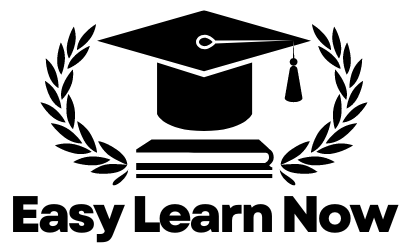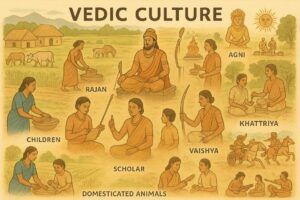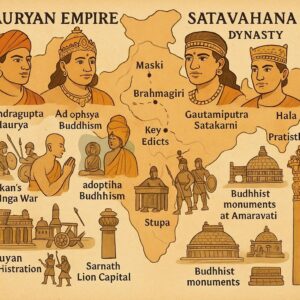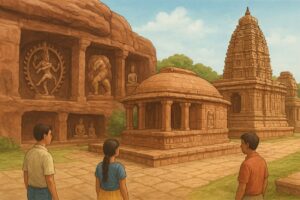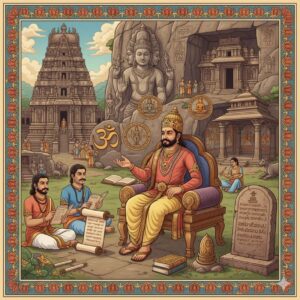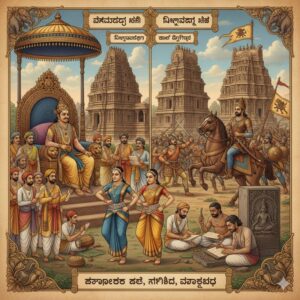2nd PUC History Question and Answer – Ancient Period
Looking for 2nd PUC History textbook answers? You can download Chapter 4: Ancient Period Questions and Answers PDF, Notes, and Summary here. 2nd PUC History solutions follow the Karnataka State Board Syllabus, making it easier for students to revise and score higher in exams.
Karnataka 2nd PUC History Textbook Answers—Reflections Chapter 4
Ancient Period Questions and Answers, Notes, and Summary
2nd PUC History Chapter 4
Ancient Period
Chapter-4.1
Scroll Down to Download Ancient Period PDF
I. Answer the following in a word or a sentence each.
Question 1.
What do you mean by the term Arya?
Answer:
The term Arya means noble, master, or a person dependent on agriculture.
Question 2.
From which word is the term Veda derived?
Answer:
The term Veda is derived from the Sanskrit word “Vid.”
Question 3.
What is meant by Veda?
Answer:
Veda means knowledge.
Question 4.
Name the first Veda.
Answer:
The first Veda is Rigveda.
Question 5.
Who was the head of the family during Vedic period?
Answer:
The head of the family during the Vedic period was called Kulapati or Grihapathi.
Question 6.
What was the main occupation of the Aryans?
Answer:
The main occupation of the Aryans was agriculture.
Question 7.
What was ‘Kshetra’?
Answer:
‘Kshetra’ was the name given to cultivated land.
Question 8.
What was considered as wealth by the Aryans?
Answer:
Cattle was considered as wealth by the Aryans.
Question 9.
What was the ceremony performed to send the child to school?
Answer:
The ceremony performed to send the child to school was Upanayanam.
II. Answer the following in two words or two sentences each
Question 1.
Name any two Vedas.
Answer:
Two Vedas are Rigveda and Yajurveda.
Question 2.
Which two political institutions assisted the king in the administration during the Vedic period?
Answer:
The two political institutions that assisted the king were Sabha (council of elders) and Samithi (assembly of people).
Question 3.
Name any two Varnas.
Answer:
Two Varnas were Brahmana and Kshatriya.
Question 4.
Name any two Ashramas of Aryans.
Answer:
Two Ashramas of Aryans were Brahmacharya and Grihastha.
Question 5.
Mention any two amusements of Vedic people.
Answer:
Two amusements of Vedic people were gambling and chariot racing.
Question 6.
Name any two women scholars of Vedic period.
Answer:
Two women scholars of Vedic period were Gargi and Maitreyi.
III. Answer the following in 15 to 20 sentences each
Question 1.
Give an account of the political condition of Aryans.
Answer:
- The Aryan tribes gradually settled in India and were called The head of the tribe was known as Rajan. His primary duty was to protect the tribe and he received gifts from the people. He was assisted by officials like the Purohita (priest), Senapati (commander), Sangrahatri (treasurer), Vispatis and Gramanis.
- The smallest unit of administration was the Grama (village), headed by a A group of villages was under a Vispati. The king was also assisted by two assemblies, the Sabha (council of elders) and the Samithi (popular assembly).
- In the Later Vedic period, Janas developed into powerful kingdoms. Kingship became hereditary and many kingdoms such as Kuru, Panchala, Kashi, and Videha emerged. The kings performed sacrifices like Rajasuya, Ashwamedha, and Vajapeya to show political supremacy.
- The military was strong and well-organized with infantry, cavalry, and elephants, though navy was little used. In the Later Vedic period, warfare became complex with improved weapons like bows, arrows, swords, spears, and helmets. Thus, Aryan political life grew from small tribes into large kingdoms with powerful kingship.
Question 2.
Explain the social condition of Aryans.
Answer:
- The Aryans followed the joint family system and their society was patriarchal. The eldest male member was the head of the family, called Kulapathi or Monogamy was common, while polygamy was confined to royal families, and widow remarriage was allowed in the early period.
- Women enjoyed a high position and had equal rights, with scholars like Vishwavara, Ghosha, and Apala composing hymns. Society was divided into four Varnas – Brahmana, Kshatriya, Vaishya, and Shudra – and people could change professions in the early period.
- In the Later Vedic period, women’s status declined, varna divisions became rigid and hereditary, and caste distinctions grew stronger. Life was divided into four Ashramas – Brahmacharya, Grihastha, Vanaprastha, and Sanyasa.
- Their food included rice, wheat, barley, fruits, vegetables, milk products, fish, and meat. They wore cotton and woolen clothes, adorned with ornaments of gold, silver, and flowers. For amusement, they enjoyed gambling, chariot racing, music, and dance, with instruments like Veena, flute, Nagari, and
Thus, Aryan society was rich and organized, though social equality declined in the Later Vedic age.
Question 3.
Enumerate the Religious condition of Aryans.
Answer:
- The religion of the Aryans is known as Sanatana Dharma or Brahmanical religion. In the Early Vedic period, they worshipped nature gods like Indra, Varuna, Agni, Vayu, Surya, Prithvi, and They were polytheists, without idol worship, and followed simple rituals like yajnas and yagas.
- In the Later Vedic period, religion became complex. The number of gods increased, idol worship started, and new deities like Brahma, Vishnu, Shiva, Ganesha, Lakshmi, and Durga were worshipped. The cow was considered sacred, and rituals became elaborate and costly.
- The Aryans believed in Varnas, Ashramas, and Purusharthas (Dharma, Artha, Kama, Moksha). They believed in rebirth and the transmigration of the soul. The ultimate aim of life was Moksha, achieved through Bhakti, Jnana, Karma, and Sacred texts included the Vedas, Upanishads, Puranas, Smritis, and epics like Ramayana and Mahabharata.
Question 4.
Write a short note on education and science during Vedic period.
Answer:
- Education during the Vedic period was imparted in Gurukulas, Pathashalas, Agraharas, and Ghatikas. Higher education was available in universities like Takshashila and Kanchi. The initiation ceremony for education was called Upanayanam. The Guru (teacher) enjoyed a high position in society.
- Both men and women were educated. Women scholars like Gargi, Maitreyi, Shashwati, and Lopamudra were famous. The subjects taught included Vedas, Puranas, Philosophy, Mathematics, Astronomy, Astrology, Logic, Medicine, and Metallurgy. Sanskrit was the medium of instruction.
- The Aryans made remarkable progress in science. In mathematics and astronomy, they calculated distances between celestial bodies and understood eclipses and comets. They also followed the lunar calendar. In medicine, they used herbs, roots, oils, salts, and mud for treatment of diseases.
Thus, Vedic education was holistic, combining spiritual, intellectual, and practical knowledge, and laid the foundation for future progress in Indian sciences.
CHAPTER 4.2
THE RISE OF NEW RELIGIONS
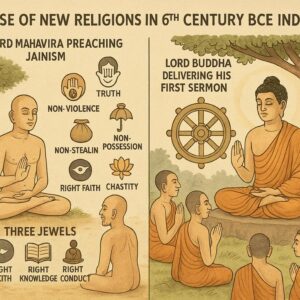
I. Answer the following in a word or a sentence each.
Question 1.
Who was the founder of Jainism?
Answer:
The founder of Jainism was Rishabhanatha, but Mahavira is regarded as the real founder who reorganized it.
Question 2.
Who was the 23rd Thirthankara?
Answer:
The 23rd Thirthankara was Parshvanatha.
Question 3.
Where was Vardhamana born?
Answer:
Vardhamana was born at Kundagrama near Vaishali.
Question 4.
Where did Vardhamana attain enlightenment?
Answer:
Vardhamana attained enlightenment at Jrimbhikagrama in Bihar.
Question 5.
Where did Mahavira attain Nirvana?
Answer:
Mahavira attained Nirvana at Pava near Rajagruha in Bihar.
Question 6.
Who founded Buddhism?
Answer:
Buddhism was founded by Gautama Buddha.
Question 7.
Where was Buddha born?
Answer:
Buddha was born at Lumbini Garden in Nepal.
Question 8.
What was the original name of Buddha?
Answer:
The original name of Buddha was Siddhartha.
Question 9.
What is the meaning of the term ‘Buddha’?
Answer:
The term ‘Buddha’ means the enlightened one.
Question 10.
In which place did Siddhartha attain enlightenment?
Answer:
Siddhartha attained enlightenment at Bodh Gaya under a pipal tree.
Question 11.
Where did Buddha deliver his first sermon?
Answer:
Buddha delivered his first sermon at Deer Park, Saranath.
Question 12.
Where did Buddha attain Nirvana?
Answer:
Buddha attained Nirvana at Kushinagara in Uttar Pradesh.
II. Answer the following in two words or two sentences each.
Question 1.
Who were the parents of Vardhamana?
Answer:
The parents of Vardhamana were King Siddhartha and Queen Trishaladevi.
Question 2.
Mention any two among the Triratnas of Vardhamana.
Answer:
Two among the Triratnas are Right Faith and Right Conduct.
Question 3.
Where were Jain councils held?
Answer:
The Jain councils were held at Pataliputra and Vallabhi.
Question 4.
Which are the sects of Jainism?
Answer:
The two sects of Jainism are Shwetambaras and Digambaras.
Question 5.
Who were the parents of Buddha?
Answer:
The parents of Buddha were King Shuddhodhana and Queen Mayadevi.
Question 6.
Mention any two of the Noble Truths preached by Buddha.
Answer:
Two Noble Truths are: Life is full of sorrow, and desire is the root cause of sorrow.
Question 7.
Name any two kings who patronized Buddhism.
Answer:
Two kings who patronized Buddhism were Ashoka and Kanishka.
Question 8.
Mention any two of the Tripitakas.
Answer:
Two of the Tripitakas are Vinaya Pitaka and Sutta Pitaka.
Question 9.
Name the sects of Buddhism.
Answer:
The sects of Buddhism are Hinayana and Mahayana.
III. Answer the following in 15 to 20 sentences each.
Question 1.
What were the factors responsible for the rise of new religions?
Answer:
India in the 6th century BCE witnessed a protest against caste system, injustice, and rigid religious practices. People longed for a simple spiritual path, which was fulfilled by Mahavira and Buddha.
The important factors responsible for the rise of new religions were:
- Complications in Vedic religion: In the beginning, Vedic religion was very simple, but later it became complicated with many rigid rituals. People became dissatisfied and looked for change.
- Supremacy of the priestly class: The Brahmanas established their superiority and people could not perform yajnas without them. They enjoyed special privileges, which created discontent.
- Animal sacrifices: Costly animal sacrifices became part of rituals. Rational thinkers considered them wasteful, and people lost faith in the existing religion.
- Chanting of Mantras: Vedic literature was in Sanskrit, a language only understood by priests. The common people could not follow it, and hence lost faith.
- Caste system: The caste system was rigid and unjust. Brahmanas enjoyed high status, while Shudras suffered greatly. This inequality caused unhappiness.
- Birth of great personalities: At this time, Mahavira and Gautama Buddha arose. They preached simple principles in the language of common people and provided an easy path to salvation.
Question 2.
Discuss the life and teachings of Mahavira.
Answer:
Mahavira, the 24th Thirthankara of Jainism, preached simple principles for the attainment of salvation. His teachings formed the foundation of Jain philosophy.
The teachings of Mahavira are as follows:
- He laid down five great vows (Panchasheela):
- Satya – Truth
- Ahimsa – Non-violence
- Astheya – Non-stealing
- Aparigraha – Non-possession of property more than required
- Brahmacharya – Chastity
- He also taught the three jewels (Triratnas):
- Right Knowledge
- Right Faith
- Right Conduct
- Mahavira did not believe in the existence of God but strongly believed in the existence of the soul.
- He condemned the caste system and animal sacrifices.
- He emphasized non-violence and taught that all beings — animals, plants, stones, water, fire, and air — have life, and hence no injury should be inflicted on any form of life.
- He advocated severe asceticism and extreme penance as the path to salvation (Nirvana).
- Mahavira had eleven disciples known as Ganadharas, who helped spread his teachings.
IV. Answer the following in 30 to 40 sentences.
Question 1.
Discuss the life and teachings of Buddha.
Answer:
Teachings of Buddha:
- Buddha preached four basic principles: Satya (truthfulness), Ahimsa (non-violence), Astheya (non-stealing), and Brahmacharya (chastity).
- He emphasized the Four Noble Truths (Arya Satyas):
- Worldly life is full of sorrow.
- Desire is the root cause of sorrow.
- When desire ceases, rebirth ceases.
- Desire can be overcome by following the Asthangamarga (Eightfold Path).
The Eightfold Path (Asthangamarga):
- Right Faith
- Right Thought
- Right Speech
- Right Conduct
- Right Effort
- Right Meditation
- Right Livelihood
- Right Mindfulness
- Buddha gave importance to conduct rather than rituals and sacrifices.
- He opposed the caste system and advocated social equality.
- He stressed Ahimsa and did not give importance to God.
- Men and women of all castes were admitted into the Sangha (religious order).
Spread of Buddhism:
Buddhism spread within India and to China, Tibet, Myanmar, Sri Lanka, Central Asia, and South-East Asia.
Causes for the Spread:
- Simple Teachings – Easy to follow, hence accepted by common people.
- Vernacular Language – Preached in Pali and Prakrit, languages of the masses.
- Equality – Rejected caste system and upheld social and gender equality.
- Personality of Buddha – His compassion, parables, and simple way of preaching attracted followers.
- Role of Sanghas – Monks and nuns traveled widely and spread Buddhism.
- Royal Patronage – Emperors like Ashoka, Kanishka, and Harshavardhana supported and spread Buddhism.
Buddhist Councils:
- First Council (483 BCE, Rajagruha) – Compiled Buddha’s sayings.
- Second Council (383 BCE, Vaishali) – Attempted to remove disputes among monks.
- Third Council (250 BCE, Pataliputra) – Patronized by Ashoka.
- Fourth Council (102 CE, Kundalavana, Kashmir) – Tried to settle differences, leading to division into Hinayana and Mahayana.
Literature:
- Buddha’s teachings were preserved in the Tripitakas (Three Baskets):
- Vinaya Pitaka – Monastic rules.
- Sutta Pitaka – Teachings and sermons.
- Abhidhamma Pitaka – Philosophical discussions.
Contributions of Buddhism:
- Development of art and architecture.
- Construction of Stupas, Viharas, and Chaityalayas (e.g., Sanchi, Amaravati, Nagarjunakonda).
- Sculptures and paintings at Amaravati, Ajanta, and Nagarjunakonda.
- Contribution to Gandhara art and spread of Indian culture abroad.
CHAPTER 4.3
MAURYAS [324 180 BCE]
I. Answer the following in a word or a sentence each.
Question 1.
Who founded the Mauryan dynasty?
Answer:
Chandragupta Maurya founded the Mauryan dynasty.
Question 2.
Name the capital of Mauryas.
Answer:
The capital of the Mauryas was Pataliputra (modern Patna).
Question 3.
Which was the Royal emblem of Mauryas?
Answer:
The Royal emblem of the Mauryas was Dharmachakra.
Question 4.
Who wrote Mudrarakshasa?
Answer:
Vishakadatta wrote Mudrarakshasa.
Question 5.
Who wrote Arthashasthra?
Answer:
Kautilya (Chanakya or Vishnugupta) wrote Arthashasthra.
Question 6.
Who wrote Indica?
Answer:
Megasthenes wrote Indica.
Question 7.
Who helped Chandaragupta to establish the Mauryan empire?
Answer:
Chanakya (Kautilya) helped Chandragupta Maurya to establish the Mauryan empire.
Question 8.
Who was the Nanda ruler defeated by Chandragupta Maurya?
Answer:
Dhanananda was the Nanda ruler defeated by Chandragupta Maurya.
Question 9.
Who sent Megasthanes as ambassador to the court of Chandragupta Maurya?
Answer:
Seleucus sent Megasthenes as ambassador to the court of Chandragupta Maurya.
Question 10.
Name the Greek ruler defeated by Chandragupta Maurya.
Answer:
Chandragupta Maurya defeated Seleucus.
Question 11.
Name the Mauryan ruler who followed Jainism.
Answer:
Chandragupta Maurya followed Jainism.
Question 12.
Where did Chandragupta Maurya spend his last days?
Answer:
Chandragupta Maurya spent his last days at Shravanabelagola in Karnataka.
Question 13.
Who was the greatest ruler of Mauryan dynasty?
Answer:
Ashoka was the greatest ruler of the Mauryan dynasty.
Question 14.
Which Ashokan edict speaks about Kalinga war?
Answer:
The XIII Rock Edict of Ashoka speaks about the Kalinga war.
Question 15.
Name the Mauryan ruler who accepted Buddhism.
Answer:
Ashoka accepted Buddhism.
Question 16.
Where was the Third Buddhist council held?
Answer:
The Third Buddhist Council was held at Pataliputra.
Question 17.
Which is the biggest Stupa built by Ashoka?
Answer:
The biggest Stupa built by Ashoka is the Sanchi Stupa.
Question 18.
Which is the National emblem of India?
Answer:
The Sarnath Lion Capital is the National emblem of India.
Question 19.
Who was the founder of Shatavahana dynasty?
Answer:
Simukha was the founder of the Shatavahana dynasty.
Question 20.
Which was the capital of Satavahanas?
Answer:
The capital of the Satavahanas was Pratishthana (modern Paithan).
Question 21.
Who wrote ‘Gathasapthasati?
Answer:
Hala wrote ‘Gathasapthasati’.
Question 22.
Which was the inscription issued by Gautami Balashri?
Answer:
The Nasik cave inscription was issued by Gautami Balashri.
II. Answer the following in two words or two sentences each.
Question 1.
Name any two important sources which help to know about Mauryan dynasty.
Answer:
The Arthashastra of Kautilya and Indica of Megasthenes are two important sources which help to know about the Mauryan dynasty.
Question 2.
Name any two places where Ashokan inscriptions have been found in Karnataka.
Answer:
Ashokan inscriptions have been found at Maski in Raichur district and Brahmagiri in Chitradurga district.
Question 3.
Which were the two types of courts that existed in the Mauryan period?
Answer:
The two types of courts in the Mauryan period were Dharmastheyas (civil courts) and Kantakashodana (criminal courts).
Question 4.
What is the importance of Maski edict?
Answer:
The Maski edict is important because it confirmed that “Devanampriya” and “Priyadarshi” referred to Ashoka himself.
Question 5.
Who was Megasthanes? Name his work.
Answer:
Megasthenes was the Greek ambassador sent by Seleucus to the court of Chandragupta Maurya, and his famous work was Indica.
Question 6
Who was Kautilya? Which is his famous work?
Answer:
Kautilya, also known as Chanakya or Vishnugupta, was a great statesman and minister of Chandragupta Maurya, and his famous work was Arthashastra.
Question 7.
Which ruler appointed Dharmamahamathras? What was their duty?
Answer:
Ashoka appointed Dharmamahamathras, and their duty was to spread Dharma among the people and look after welfare activities.
Question 8.
Name any two important rulers of Sathavahanas.
Answer:
Two important rulers of the Sathavahanas were Gautamiputra Satakarni and Hala.
Question 9.
Name any two architectural centres of Sathavahanas.
Answer:
Two architectural centres of the Sathavahanas were Amaravathi and Nagarjunakonda.
III. Answer the following in 10–12 sentences each.
Question 1.
Achievements of Chandragupta Maurya
Answer:
Chandragupta Maurya founded the Mauryan dynasty in 324 BCE with the help of Chanakya. He defeated the Nanda ruler Dhanananda and unified most of India under one empire. He conquered Punjab and annexed north-western territories from Greek control. Chandragupta also defeated Seleucus, gaining Afghanistan, Kabul, Kandahar, and Baluchistan, and married Seleucus’ daughter.
He established a strong army and a well-organized administrative system. Megasthenes served as his ambassador to Pataliputra. Towards the end of his reign, he embraced Jainism under Bhadrabahu and spent his last days at Shravanabelagola. Chandragupta laid the foundation of a strong, centralized Mauryan empire.
Question 2.
Measures taken by Ashoka for the spread of Buddhism
Answer:
Ashoka embraced Buddhism after the Kalinga war in 261 BCE. He visited holy sites like Lumbini, Bodh Gaya, Sarnath, and Kushinagar. He built monasteries, stupas, and engraved Buddhist teachings on rocks and pillars. Ashoka appointed Dharmamahamathras to spread Dharma and organize welfare activities.
He sent missionaries abroad, including his children Mahendra and Sanghamitra to Sri Lanka. He organized the Third Buddhist Council at Pataliputra. He also promoted moral values like truth, non-violence, and compassion among his subjects. Ashoka combined religious propagation with social welfare, making Buddhism widely known in and outside India.
Question 3.
Administration of Mauryas
Answer:
The king was the supreme authority in the Mauryan Empire, assisted by the Mantriparishad (council of ministers). The central government had 30 departments managing irrigation, trade, education, and famine relief. Courts included Dharmastheyas (civil) and Kantakashodana (criminal). Land revenue was the main source of income, and taxes were collected in cash and kind.
The empire was divided into five provinces, each under a governor, further divided into districts and villages. Cities like Pataliputra had committees to manage roads, markets, water, and hospitals. The army included infantry, cavalry, elephants, and chariots, organized efficiently under six boards. The Mauryan system was uniform, centralized, and highly organized.
Question 4.
Contributions of Mauryas to Art and Architecture
Answer:
Mauryan architecture shifted from wood to stone under Ashoka. He built stupas, including the famous Sanchi Stupa. Chandragupta’s palace at Pataliputra was grand, described by Fa-Hien. Ashoka and his grandson Dasharatha built meditation caves for monks at Barabar and Nagarjuna hills. Ashoka constructed over 30 stone pillars, the most famous being the Sarnath pillar with the four lions, lotus, and Dharma Chakra. These pillars and stupas influenced Indian architecture for centuries. Mauryan contributions laid the foundation of stone construction and monumental art in India.
IV. Answer the following in 20–25 sentences.
Question 1.
Life and Achievements of Ashoka
Answer:
- Ashoka, son of Bindusara, ruled from 273–232 BCE and became king after a succession struggle. Known as Devanampriya and Priyadarshi, he initially followed military conquests. The Kalinga war in 261 BCE changed his life due to its mass bloodshed. Ashoka renounced warfare and adopted Dharmavijaya—winning hearts through Dharma. He embraced Buddhism under Upa Gupta and visited holy sites like Lumbini, Bodh Gaya, Sarnath, and Kushinagar.
- Ashoka built stupas, monasteries, and inscribed edicts on rocks, pillars, and caves. He appointed Dharmamahamathras to spread Dharma and organize welfare. He sent missionaries abroad, including Mahendra and Sanghamitra to Sri Lanka. He organized the Third Buddhist Council at Pataliputra. Ashoka’s administration promoted moral values, social welfare, and justice. He dug wells, built roads, planted trees, and constructed hospitals.
- His empire extended from Afghanistan and Kashmir in the north to Karnataka in the south, and from Bengal in the east to Sindh and Baluchistan in the west. Ashoka’s edicts, written in Prakrit, Pali, and Greek, provide insights into his ideals and administration. The Maski edict confirmed “Devanampriya” referred to Ashoka. He also contributed to art and architecture, with the Sanchi Stupa and Sarnath Lion Capital being iconic monuments. Ashoka is remembered as a ruler who gave up war after victory and devoted his life to peace, Dharma, and the welfare of his people.
CHAPTER 4.4
KUSHANAS
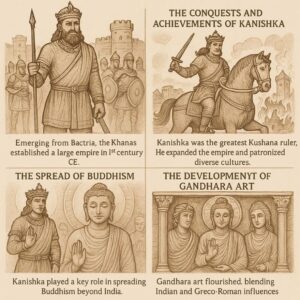
I. Answer in a word or sentence each
Question 1.
Which was the original home of the Kushanas?
Answer:
The Kushanas originally lived in China.
Question 2.
Who was the first ruler of the Kushanas?
Answer:
Kujula Kadphisis (Kadphisis I) was the first ruler.
Question 3.
Who was the greatest king of the Kushanas?
Answer:
Kanishka was the greatest king of the Kushanas.
Question 4.
Name the Chinese general who defeated Kanishka.
Answer:
General Pan-chao defeated Kanishka initially.
Question 5.
Which was the capital of Kanishka?
Answer:
Purushapura (modern Peshawar) was the capital of Kanishka.
Question 6.
Who influenced Kanishka to embrace Buddhism?
Answer:
Kanishka embraced Buddhism under the influence of Ashwaghosha.
II. Answer in two words or two sentences each
Question 1.
Why was the fourth Buddhist council held? When?
Answer:
The fourth Buddhist council was held to settle disputes in Buddhism and to compile a commentary on the holy books (Pitikas). It was held at Kundalavana in Kashmir in 102 CE.
Question 2.
Write any two measures of Kanishka for the spread of Buddhism.
Answer:
- Buddhism was given royal patronage and viharas and monasteries were built for monks.
- Missionaries were sent to countries like China, Tibet, and Japan to spread Buddhism.
III. Answer in 15–20 sentences each
Question 1.
Explain the achievements of Kanishka.
Answer:
- Kanishka was the greatest Kushana king, with his capital at Purushapura (modern Peshawar). He expanded his empire to Bactria, Persia, Afghanistan, Punjab, Sindh, Kashmir, and parts of Magadha. He defeated the Saka Satraps and annexed three Chinese provinces: Kashgar, Yarkhand, and Khothan, becoming the first Indian ruler to hold territories outside India.
- Kanishka initially followed Hinduism but later embraced Buddhism under Ashwaghosha’s influence. He promoted Buddhism by giving royal patronage, building viharas and monasteries, sending missionaries to Central and East Asia, and conducting the fourth Buddhist council at Kundalavana in 102 CE, which produced the Mahavibhasa.
- He was also a great patron of art, encouraging the Gandhara School, a Greeko-Buddhist style that blended Indian and Greek traditions.
Question 2.
Describe chief characteristics of the Gandhara School of art?
Answer:
1. In this school of art the life size statues of Gautama Buddha were carved. Until then, the Buddhist existence was shown in the form of symbols like lotus, umbrella, etc..
- While carving the statues utmost care was given to the symmetry of the body including the muscles and moustaches which were shown in a natural setting.
- In the specimens of the craftsmanship of this art the folds and turns of the clothes were exhibited with minute care and skill.
- In this art the ornaments that were carved on the statues received much attention which added to the physical beauty of the statue.
- Polishing the statues is an important feature of this art.
- The specimens were mostly prepared in stone, terracotta and clay.
- The technique used in making the statues was Greek but, the idea, Inspiration and personality all were Indian.
CHAPTER 4.5
GUPTAS (300-600CE)
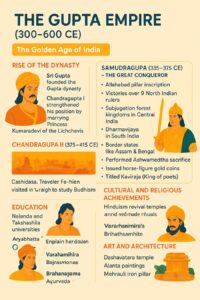
I. Answer the following in a word or a sentence each
Question 1.
Who was the founder of the Gupta dynasty?
Answer:
The founder of the Gupta dynasty was Sri Gupta.
Question 2.
When did the Gupta Era commence?
Answer:
The Gupta Era commenced in 320 CE with the accession of Chandragupta I.
Question 3.
Who composed the Allahabad pillar inscription?
Answer:
The Allahabad pillar inscription was composed by Harisena, the court poet of Samudragupta.
Question 4.
Which inscription of Samudragupta reveals his expeditions?
Answer:
The Allahabad pillar inscription reveals the expeditions of Samudragupta.
Question 5.
Who is the author of Kavyamimamse?
Answer:
The author of Kavyamimamse was Rajashekara.
Question 6.
Who was the greatest king of the Gupta dynasty?
Answer:
The greatest king of the Gupta dynasty was Samudragupta.
Question 7.
Which Gupta ruler performed Ashwameda sacrifice?
Answer:
The Ashwameda sacrifice was performed by Samudragupta.
Question 8.
Who had the title ‘Kaviraja’?
Answer:
Samudragupta had the title of Kaviraja (King of poets).
Question 9.
Who wrote Shakunthala?
Answer:
Kalidasa wrote Shakunthala.
Question 10.
Who wrote Aryabhatia?
Answer:
Aryabhatta wrote Aryabhatia.
Question 11.
Who had the title Vikramaditya?
Answer:
Chandragupta II had the title Vikramaditya.
Question 12.
Who wrote Amarakosha?
Answer:
Amarasimha wrote Amarakosha.
Question 13.
Who wrote Brihathsamhite?
Answer:
Varahamihira wrote Brihathsamhite.
Question 14.
Who wrote ‘Gho-ko-ki’?
Answer:
Fa-hien, the Chinese traveler, wrote ‘Gho-ko-ki’.
Question 15.
Name the author of Kiratarjuniyam.
Answer:
The author of Kiratarjuniyam was Bharavi.
Question 16.
Who is called The Father of Indian Medicine?
Answer:
Dhanvanthri is called the Father of Indian Medicine.
Question 17.
In which place is the Iron pillar of the Gupta age found?
Answer:
The Iron pillar of the Gupta age is found at Mehrauli near Delhi.
II. Answer the following in two words or two sentences each
Question 1.
Which were the two capitals of the Guptas?
Answer:
The two capitals of the Guptas were Pataliputra and Ujjain.
Question 2.
Which inscription describes the conquests of Samudragupta? Who composed it?
Answer:
The Allahabad pillar inscription describes the conquests of Samudragupta, and it was composed by Harisena.
Question 3.
Name any two poets of the Gupta period.
Answer:
Two poets of the Gupta period were Kalidasa and Bharavi.
Question 4.
Mention any two works of Kalidasa.
Answer:
Two works of Kalidasa are Raghuvamsha and Shakunthala.
Question 5.
Who was Fa-hien? Why did he come to India?
Answer:
Fa-hien was a Chinese Buddhist monk who came to India to study Buddhism in the land of its birth.
Question 6.
Name any two sources which help us to know about Gupta History.
Answer:
Two sources that help us to know about Gupta history are the Allahabad pillar inscription and the works of Kalidasa.
Question 7.
Name any two North Indian rulers defeated by Samudragupta.
Answer:
Two North Indian rulers defeated by Samudragupta were Nandin and Balavarman.
Question 8.
Name any two South Indian kingdoms defeated by Samudragupta.
Answer:
Two South Indian kingdoms defeated by Samudragupta were Kanchi (Vishnugopa) and Vengi (Hasthivarman).
Question 9.
Name any two well known universities of the Gupta period.
Answer:
Two well-known universities of the Gupta period were Nalanda and Takshashila.
Question 10.
Name any two works of Varahamihira.
Answer:
Two works of Varahamihira are Brihathsamhite and Panchasiddhantika.
Question 11.
Name any two architectural centers of Gupta period.
Answer:
Two architectural centers of the Gupta period were Mathura and Devgarh.
III. Answer the following in 15 to 20 sentences
Question 1.
Explain the conquests of Samudra Gupta.
Answer:
- Samudragupta, who ruled from 335 CE to 375 CE, was the greatest king of the Gupta dynasty and is remembered as a great conqueror. His military achievements are mainly known from the Allahabad pillar inscription composed by Harisena, his court poet. Samudragupta undertook several campaigns to expand and consolidate his empire. His conquests may be divided into four categories.
- First, in his North Indian campaign, he defeated nine rulers of Aryavarta, including Nandin, Balavarman, Chandravarman, Nagasena and others. These territories were annexed directly into his empire. Second, in the conquest of forest kingdoms, he subdued the rulers of the Vindhya region, such as Jabbalpura, Reva, Nagapura, and Bhaghelkhand.
- Third, he launched a South Indian campaign, in which he traveled about 3,000 miles. He defeated twelve South Indian rulers including Vishnugopa of Kanchi, Hasthivarman of Vengi, and Mahendra of Kosala. However, instead of annexing their territories, he reinstated them as his vassals who paid tribute. This policy was called Dharmavijaya.
- Finally, in the conquest of border states, Samudragupta established his authority over states like Kamarupa (Assam), Samatata (Bengal), Karthripura (Punjab), and Rohilkhand.
- To commemorate his victories, he performed the Ashwameda sacrifice and issued coins with the figure of a horse. His empire extended from Kashmir in the north to Tamil Nadu in the south, and from Punjab in the west to Bengal in the east. Thus, Samudragupta earned the title of Chakravarthi and established himself as a powerful emperor of India.
IV. Answer the following in 30 to 40 sentences
Question 1.
Why is Gupta age called ‘The Golden Age’ in Indian History?
Answer:
- The Gupta age, which lasted from 300 CE to 600 CE, is called the Golden Age of Indian history because of the all-round progress made in political, religious, cultural, educational, literary, scientific, and artistic fields.
- Politically, the Guptas created a large and powerful empire after the decline of the Mauryas and brought unity in North India. Kings like Samudragupta and Chandragupta II (Vikramaditya) expanded the empire through conquests and alliances. The administration was efficient and strong.
- Religiously, the Gupta rulers were devout Hindus and promoted Hinduism as the state religion. The worship of Vishnu, Shiva, and Durga became popular. Rituals like Ashwameda, Vajapeya, and Rajasuya were performed. At the same time, the rulers were tolerant of Buddhism and Jainism. Many temples were built, and the title Paramabhagavatha was assumed by rulers to show devotion to Lord Vishnu.
- In the field of education, universities like Nalanda, Takshashila, Vallabhi, and Ajantha became world-famous. Students from abroad also came to study there. Subjects like literature, philosophy, astronomy, mathematics, medicine, and astrology were taught.
- The period saw a remarkable growth of Sanskrit literature. Kalidasa, the greatest poet and dramatist, wrote works such as Shakunthala, Meghaduta, Raghuvamsha, and Kumarasambhava. Other scholars included Bharavi, Vishakadatta, Shudraka, and Bhavabuti. The court of Chandragupta II was adorned by the famous Navaratnas (nine gems) including Kalidasa, Amarasimha, and Varahamihira.
- In science and mathematics, great scholars like Aryabhatta explained the rotation of the earth and the cause of eclipses in his work Aryabhatia. He introduced the decimal system. Brahmagupta highlighted the concept of zero. Varahamihira wrote Brihathsamhite and contributed to astronomy, geography, and botany. In medicine, Charaka, Sushruta, and Dhanvanthri made significant contributions. The Mehrauli iron pillar is a marvel of Gupta metallurgy.
- In art and architecture, the Guptas developed the structural style of temples. Important examples include the Dashavatara temple of Devgarh and the brick temple of Bhitargaon. Beautiful Buddha statues and cave paintings at Ajanta and Bagh reflect their excellence in sculpture and painting.
- Because of these outstanding achievements in all spheres of life, the Gupta period is rightly called the Golden Age of Indian History, comparable to the classical ages of Greece, Rome, and England.
CHAPTER 4.6
CHOLAS SANGAM AGE
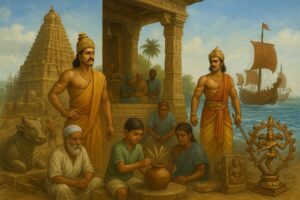
I. Answer the following in a word or a sentence each:
Question 1.
What is meant by Sangam?
Answer:
Sangam means a Tamil Literary Union where poets and scholars composed literature.
Question 2.
Who was the first Chola king of Sangam age?
Answer:
Ilain Chola was the first Chola king of the Sangam age.
Question 3.
Who built the Rajarajeshwara temple at Tanjore?
Answer:
Rajaraja Chola I built the Rajarajeshwara temple at Tanjore.
Question 4.
Which inscription tells about the Chola village administration?
Answer:
The Uttarameruru inscription tells us about the Chola village administration.
Question 5.
What is meant by ‘Kuduvalai’?
Answer:
Kuduvalai means the lucky draw system used to elect representatives in the Chola village administration.
Question 6.
What is meant by ‘Varriam’?
Answer:
Varriam means the committees formed in villages to look after administration such as gardens, tanks, and annual works.
II. Answer the following in two words or two sentences each:
Question 1.
Name any two famous works of the Sangam age.
Answer:
Two famous works of the Sangam age are Tirukkural and Silappadikaram.
Question 2.
When and between whom did the battle of Takkolam take place?
Answer:
The battle of Takkolam took place in 949 CE between the Cholas and the Rashtrakutas.
Question 3.
Mention any two titles of Rajendra Chola I.
Answer:
Two titles of Rajendra Chola I were Gangaikonda Chola and Pandita Chola.
III. Answer the following in 15 to 20 sentences each:
Question 1.
Sketch the achievements of Rajaraja Chola I.
Answer:
Rajaraja Chola I (985–1014 CE) was the greatest Chola ruler who revived and strengthened the empire after Rashtrakuta invasions. In his southern conquests, he defeated the Pandya king Amarabhujanga, destroyed the Chera navy, and occupied northern Ceylon, where he built a Shiva temple at Polonnaruwa. In the north, he conquered Gangawadi, Nolambawadi, and renamed Talakadu as Rajarajapura. He interfered in Vengi politics, supported Shaktivarma, and strengthened ties with the Vengi Chalukyas through a marriage alliance. He also conquered Kalinga and extended his empire up to Orissa, Coorg, Konkan, Maldives, and Lakshadweep.
He maintained friendly relations with the Shailendra kingdom of Sumatra and permitted the building of a Buddhist Vihara at Nagapattinam. His empire stretched across South India and overseas islands. Rajaraja Chola held titles like Shivapadashekhara and Mummadi Choladeva. As a patron of art and architecture, he built the famous Rajarajeshwara (Brihadeshwara) temple at Tanjore. His military and cultural achievements made him one of the greatest emperors in South Indian history.
Question 2.
Describe the achievements of Rajendra Chola I.
Answer:
Rajendra Chola I (1012–1044 CE), son of Rajaraja Chola I, further expanded the Chola empire. He defeated Mahendra V of Ceylon, annexed the island, and brought the Pandya regalia kept there. He defeated Jayasimha II of the Kalyani Chalukyas at Masangi and placed Rajaraja Narendra on the Vengi throne, strengthening the Chalukya–Chola alliance. He defeated Mahipala I of Bengal, and his army reached the River Ganga, bringing back its holy water.
To commemorate this, he founded Gangaikonda Cholapuram and earned the title Gangaikonda Chola. In 1025 CE, he sent a naval expedition against Srivijaya, conquering Sumatra and Java. He built the Gangaikonda Chola temple and developed Cholagangam, a large tank. As a patron of learning, he established an educational centre at Ennayiram with free facilities for students. He also sent ambassadors to China in 1033 CE. His titles included Pandita Chola and Kedarakonda Deva. Rajendra Chola’s victories and administration brought great prestige to the empire.
Question 3.
Describe the village administration of the Cholas.
Answer:
The Cholas had an efficient village administration, considered their greatest contribution. Villages enjoyed self-rule through elected representatives. The Uttarameruru inscription gives details of this system. Villages were divided into thirty units (Kudumbu), and representatives were chosen annually through the Kuduvalai system, where a child picked names written on palm leaves. The elected members worked in committees called Varriams, such as the Annual Committee, Garden Committee, and Tank Bund Committee.
These bodies managed taxes, temples, forests, lakes, and village property. Members had to meet qualifications such as owning taxable land, being 35–70 years old, and having knowledge of Vedas and commerce. They were disqualified if guilty of crimes or if they failed to submit accounts. This system ensured accountability and fairness. Hence, Chola villages are often described as “small democratic states.”
CHAPTER 4.7
VARDHANAS AND EARLY CHALUKYAS – PALLAVAS
I. Answer the following in a word or a sentence each.
Question 1.
Who was the greatest ruler of the Vardhanas?
Answer:
The greatest ruler of the Vardhanas was Harshavardhana.
Question 2.
Which was the capital of Harshavardhana?
Answer:
The capital of Harshavardhana was Thaneshwar, and later he made Kanauj his second capital.
Question 3.
Who was the sister of Harshavardhana?
Answer:
The sister of Harshavardhana was Rajashri.
Question 4.
Who wrote Harshacharita?
Answer:
Banabhatta wrote Harshacharita.
Question 5.
Who was famous as ‘Uttarapatheshwara’?
Answer:
Harshavardhana was famous as Uttarapatheshwara.
Question 6.
Who presided over the religious conference at Kanauj?
Answer:
Hiuen Tsang (Hieuntsang) presided over the religious conference at Kanauj.
Question 7.
When was the Buddhist Council at Prayag held?
Answer:
The Buddhist Council at Prayag was held in 643 CE.
Question 8.
Who was the founder of Kadamba dynasty?
Answer:
Mayuravarma was the founder of the Kadamba dynasty.
Question 9.
Which is the first Kannada inscription?
Answer:
The Halmidi inscription is the first Kannada inscription.
Question 10.
Who was the famous ruler of Gangas?
Answer:
Durvinitha was the most famous ruler of the Gangas.
Question 11.
Which was the capital of Early Chalukyas?
Answer:
The capital of the Early Chalukyas was Badami (Vatapi).
Question 12.
Who was the famous ruler of Badami Chalukyas?
Answer:
The famous ruler of the Badami Chalukyas was Pulikeshi II.
Question 13.
Which was the Royal Emblem of Badami Chalukyas?
Answer:
The Royal Emblem of the Badami Chalukyas was Varaha (boar).
Question 14.
Who was famous as ‘Dakshinapatheshwara’?
Answer:
Pulikeshi II was famous as Dakshinapatheshwara.
Question 15.
Who composed the Aihole inscription?
Answer:
The Aihole inscription was composed by Ravikirti.
Question 16.
Name the work composed by Vijayabhattarike.
Answer:
The work composed by Vijayabhattarike was Kaumudi Mahotsava.
Question 17.
Which was the work of Hieuntsang?
Answer:
The work of Hieuntsang was Si-yu-ki.
II. Answer the following in two words or two sentences each.
Question 1.
Who were the parents of Harshavardhana?
Answer:
The parents of Harshavardhana were Prabhakara Vardhana and Yashomathi.
Question 2.
Name any two literary works of Harshavardhana.
Answer:
Two literary works of Harshavardhana are Ratnavali and Nagananda.
Question 3.
Who erected the Gommateshwara statue and where?
Answer:
The Gommateshwara statue was erected by Chavundaraya at Shravanabelagola.
Question 4.
Name any two titles of Pulikeshi II.
Answer:
Two titles of Pulikeshi II were Parameshwara and Dakshinapatheshwara.
Question 5.
Name any two temples of Aihole.
Answer:
Two temples of Aihole are the Durga temple and the Ladhkhan temple.
Question 6.
Name any two temples of Pattadakallu.
Answer:
Two temples of Pattadakallu are the Virupaksha temple and the Mallikarjuna temple.
Question 7.
Name any two important architectural centres of Pallavas.
Answer:
Two important architectural centres of the Pallavas are Kanchi and Mahabalipuram.
III . Answer the following in 15 to 20 sentences each.
Question 1.
Describe the achievements of Harshavardhana.
Answer:
Harshavardhana (606–647 CE) was the greatest ruler of the Vardhana dynasty. He made Kannauj his capital and extended his empire over North India. Though he tried to conquer the South, he was defeated by Pulikeshi II of Badami. He earned the title ‘Uttarapatheshwara’ for his dominance in northern India. Harsha was first a Shaiva but later adopted Buddhism and promoted religious tolerance. He held the Kanauj assembly and the Prayag Council where he donated wealth to all religions. His court poet Banabhatta wrote Harshacharita and Kadambari. Harsha himself wrote three plays—Ratnavali, Priyadarshika, and Nagananda. The Chinese traveler Hiuen Tsang visited his court and praised his rule. He was the last great emperor of North India before Muslim invasions.
Question 2.
Explain the Chalukya–Pallava conflict.
Answer:
The Chalukya–Pallava conflict was a major struggle in South India. Pulikeshi II of the Badami Chalukyas defeated Mahendravarman I of the Pallavas and expanded his power. Later, Narasimhavarman I took revenge by defeating Pulikeshi II in 642 CE. He captured and destroyed Vatapi (Badami), earning the title ‘Vatapikonda’. This weakened the Chalukyas for some time. Later, Vikramaditya I restored their power. The long rivalry drained both kingdoms but also encouraged growth in art and architecture.
Question 3.
Write about the contributions of Chalukyas of Badami to art and architecture.
Answer:
The Badami Chalukyas made important contributions to Indian art and architecture. They built both rock-cut caves and structural temples. At Badami, four cave temples dedicated to Shiva, Vishnu, and Jain Tirthankaras are famous for sculptures like Nataraja and Varaha. At Aihole, called the “Cradle of Indian Architecture,” over 70 temples were built, including the Durga temple and Lad Khan temple. At Pattadakallu, they built temples in both Dravidian and Nagara styles. The Virupaksha temple, built by Queen Lokamahadevi, is their finest example. Their art blended North and South Indian styles and influenced later dynasties.
IV. Answer the following in 30 to 40 sentences.
Question 1.
Describe the achievements of Pulikeshi II.
Answer:
- Pulikeshi II was the greatest king of the Chalukyas of Badami. He ruled from 610 CE to 642 CE and made the Chalukya dynasty powerful in South India. He was a brave warrior, an able administrator, and a patron of art and culture. His reign is well recorded in the Aihole inscription composed by his court poet Ravikirti.
- Pulikeshi II first consolidated his position by defeating his relatives and local chiefs who opposed his rule. He brought the whole region between the rivers Krishna and Tungabhadra under his control. He then turned his attention towards the neighbouring dynasties.
- In the South, he defeated the Kadambas of Banavasi, the Alupas of South Canara, and the Gangas of Talakad. By these victories, he established his supremacy in Karnataka.
- In the West, he subdued the Mauryas of Konkan and extended his rule up to the Arabian Sea. In the East, he defeated the rulers of Andhra and Kalinga, bringing those regions under his influence. He also brought the Latas, Malwas, and Gurjaras of western India under his control.
- Pulikeshi II earned the title ‘Dakshinapatheshwara’ (Lord of the Deccan) because he established a vast empire in the South. His greatest achievement was his conflict with the Pallavas of Kanchi. He defeated Mahendravarman I of the Pallavas and captured some of their territories. Later, when Narasimhavarman I came to power, Pulikeshi II was defeated and Vatapi was captured by the Pallavas.
- In the North, Pulikeshi II achieved great fame. He crossed the Narmada and checked the advance of Harshavardhana, the powerful ruler of Kannauj. Harsha was forced to retreat and Pulikeshi II became famous as the protector of the Deccan. This victory made him well known throughout India.
- His empire extended from the Arabian Sea in the west to the Bay of Bengal in the east, and from the Narmada in the north to the Kaveri in the south. Thus, he built one of the largest empires of South India.
- Pulikeshi II maintained friendly relations with foreign rulers. The Chinese king sent an envoy to his court. His capital Vatapi (Badami) became a great cultural and political centre. He encouraged art and architecture. The rock-cut temples of Badami and structural temples at Aihole and Pattadakallu flourished during his reign.
- Pulikeshi II was not only a conqueror but also a good administrator. He divided his empire into provinces and appointed governors to maintain law and order. He respected all religions and gave patronage to Brahmanism, Jainism, and Buddhism.
- Though he was later defeated by the Pallavas, his reign remains a glorious chapter in Deccan history. His military conquests, strong administration, and patronage of culture made him one of the greatest kings of South India.
- Thus, Pulikeshi II was rightly called the “Lion of the South” and remembered as one of the most successful rulers of the Chalukyas of Badami.
CHAPTER 4.8
RASHTRAKUTAS
I. Answer the following in a word or a sentence each.
Question 1.
What was the royal emblem of the Rashtrakutas?
Answer:
The royal emblem of the Rashtrakutas was the Garuda.
Question 2.
Which was the capital of the Rashtrakutas?
Answer:
The capital of the Rashtrakutas was Manyakheta.
Question 3.
Who was the first king of the Rashtrakutas?
Answer:
The first king of the Rashtrakutas was Dantidurga.
Question 4.
Who was the greatest ruler of the Rashtrakutas?
Answer:
The greatest ruler of the Rashtrakutas was Amoghavarsha I.
Question 5.
Who was the foreign traveller who visited the court of Amoghavarsha?
Answer:
The foreign traveller who visited the court of Amoghavarsha was Sulaiman, the Arab traveller.
Question 6.
Which was the first literary work in Kannada?
Answer:
The first literary work in Kannada was Kavirajamarga.
Question 7.
Who was called ‘Ubhaya Kavichakravarthi’?
Answer:
Ponna was called “Ubhaya Kavichakravarthi”.
Question 8.
Who patronized Ponna?
Answer:
Krishna III of the Rashtrakutas patronized Ponna.
Question 9.
Who is called Adikavi of Kannada?
Answer:
Pampa is called the “Adikavi of Kannada”.
Question 10.
Who patronized Pampa?
Answer:
Arikesari II, the feudatory of the Rashtrakutas at Vemulavada, patronized Pampa.
II. Answer the following in two words or two sentences each.
Question 1.
Who built the Kailasanatha temple? Where was it built?
Answer:
The Kailasanatha temple was built by Krishna I at Ellora.
Question 2.
Name any two titles of Dhruva.
Answer:
Two titles of Dhruva are Dharavarsha and Kalivallabha.
Question 3.
Write any two titles of Govinda III.
Answer:
Two titles of Govinda III are Jagattunga and Prabhutavarsha.
Question 4.
Write any two titles of Amoghavarsha.
Answer:
Two titles of Amoghavarsha are Nrupatunga and Veeranaryana.
Question 5.
Name any two works of Ponna.
Answer:
Two works of Ponna are Shantinathapurana and Bhuvanaikya Ramabhyudaya.
Question 6.
Name any two works of Pampa.
Answer:
Two works of Pampa are Vikramarjuna Vijaya (Pampa Bharatha) and Adipurana.
III. Answer the following in 15 to 20 sentences each.
Question 1.
Describe the achievements of Govinda III.
Answer:
- Govinda III, son of Dhruva Dharavarsha, came to power in 793 CE.
- He defeated his brother Stambha and the Ganga ruler Shivamara, though he later pardoned them.
- In North India, he defeated Nagabhatta II of the Pratiharas, Dharmapala of Bengal, and Chakrayudha of Kanauj.
- His army marched up to the Himalayas, where his horses drank from the rivers and his elephants bathed in the Ganga.
- In the South, he crushed the combined forces of the Pandyas, Gangas, and Kerala rulers in 803–804 CE.
He defeated the Pallava ruler Dantivarma and collected tributes from him. - The ruler of Simhala (Sri Lanka) also surrendered to him.
His empire extended from the Himalayas to Kanyakumari, and from Saurashtra to Bengal. - Govinda III assumed titles like Jagattunga and Prabhutavarsha.
- Thus, he was one of the greatest conquerors of the Rashtrakutas.
Question 2.
Describe the achievements of Amoghavarsha.
Answer:
- Amoghavarsha I, son of Govinda III, came to power in 814 CE and is considered the greatest Rashtrakuta ruler.
- He defeated the Vengi Chalukya ruler Gunaga Vijayaditya III but later preferred peace.
- He strengthened his kingdom through matrimonial alliances with the Gangas, Eastern Chalukyas, and Pallavas.
- He was tolerant of all religions and compared to Ashoka for his peace-loving nature.
- Amoghavarsha himself wrote Prashnottara Ratnamala in Sanskrit and encouraged scholars like Ponna, Jinasena, and Srivijaya.
- During his reign, the first Kannada work Kavirajamarga was composed.
- The Arab traveller Sulaiman visited his capital Manyakheta in 851 CE and praised the Rashtrakuta empire as one of the greatest in the world.
- He held titles like Nrupatunga and Veeranaryana.
Thus, Amoghavarsha was famous as a scholar, patron of learning, and benevolent ruler.
IV. Answer the following in 30 to 40 sentences.
Question 1.
Describe the cultural contributions of Rashtrakutas.
Answer:
Cultural Contributions of Rashtrakutas
1. Religion:
- Rashtrakuta rulers were highly tolerant of different religions.
- Though followers of Vedic religion, they patronized Jainism and Buddhism.
- Amoghavarsha was a devotee of Kolhapur Mahalakshmi.
- Brahmanas were engaged in performing yagas and yajnas, and kings supported them with donations.
- Buddhist Sanghas existed in places like Kanheri near Mumbai.
2. Literature:
- Rashtrakutas were great patrons of Kannada and Sanskrit literature.
- Kavirajamarga, the first Kannada work, was composed by Sri Vijaya.
- Ponna wrote Shantinathapurana and Bhuvanaikya Ramabhyudaya; he was called Ubhayakavi Chakravarti.
- Pampa, patronized by Arikesari II, wrote Vikramarjuna Vijaya (Pampa Bharatha) and Adipurana; he is called Adikavi of Kannada.
- Shivakotyacharya wrote Vaddaradhane, the first prose work in old Kannada.
- Important Sanskrit works included Shabdanushasana (Shaktayana), Ganithasarasangraha (Mahaveeracharya), Prashnottararatnamala (Amoghavarsha), Madalasachampu (Trivikrama), Adipurana and Parshvabhyudaya (Jinasenacharya), Vardhamana Purana (Asaga), Mruta Sanjeevini and Kavirahasya (Halayudha).
3. Art and Architecture:
- Rashtrakutas built structural temples, cave temples, and basadis.
- Famous centres: Ellora, Ajanta, Elephanta.
- Kailasanatha Temple, Ellora: Built by Krishna I in 770 CE; 164 ft long, 109 ft wide, 92 ft high; Dravidian style; includes Mahadwara, Shikara, Garbhagriha, Nandi Mantapa, sculptures of Shivaleela, Asthadikpalakas, Ganga-Yamuna, Saraswati, and Ravana lifting Kailasa.
- Other Ellora temples: Ravana’s cave, Dasavatara, Rameshwara, Dumar Lena, Neelakantha cave, Indra Sabha, Jagannatha Sabha.
- Elephanta Caves: 7 caves; central Trimurti sculpture (18 ft) represents creation, preservation, and destruction; includes Dwarapalaka, Ardhanareeshwara, Shiva-Parvati, and other bas-reliefs.
- Cave paintings at Ellora show Rashtrakutas patronized painting and visual arts.
CHAPTER 4.9
LATER CHALUKYAS AND HOYSALAS
I. Answer in a word or a sentence each
Question 1.
Who was the founder of Chalukyas of Kalyana?
Answer:
Tailapa II
Question 2.
Which was the first capital of Chalukyas of Kalyana?
Answer:
Manyakheta
Question 3.
Who was the patron of Ranna?
Answer:
Sathyashraya
Question 4.
Who had the title ‘Kavichakravarthi’?
Answer:
Ranna
Question 5.
Which work is considered as the first encyclopedia of Sanskrit?
Answer:
Manasollasa by Someshwara III
Question 6.
Who was the founder of Hoysala kingdom?
Answer:
Sala
Question 7.
What was the Royal Emblem of Hoysalas?
Answer:
Sala killing a tiger
II. Answer in two words or two sentences each
Question 1.
Who started Vikrama Era and when?
Answer:
Vikramaditya VI started Vikrama Era in 1076 CE.
Question 2.
Mention any two titles of Vikramaditya VI.
Answer:
Permadideva, Tribhuvanamalla
Question 3.
Name any two works of Ranna.
Answer:
Ajitanatha Purana, Sahasa Bhima Vijaya (Gadhayuddha)
Question 4.
Who was the court poet of Vikramaditya VI? Name his work.
Answer:
Bilhana; Vikramankadeva Charitham
Question 5.
Name any two capitals of Hoysalas.
Answer:
Dwarasamudra (Halebeedu), Belur
Question 6.
Mention any two titles of Vishnuvardhana.
Answer:
Mahamandaleshwara, Chalukya-mani-Mandalika Chudamani
Question 7.
Name any two famous temples of Hoysalas.
Answer:
Channakeshava at Belur, Hoysaleshwara at Halebeedu
III. Answer in 15–20 sentences each
Question 1.
Explain the cultural contributions of Chalukyas of Kalyana.
Answer:
The Chalukyas of Kalyana were great patrons of art, literature, and architecture. Kannada and Sanskrit literature flourished under their rule. Famous poets like Ranna (Ajitanatha Purana, Sahasa Bhima Vijaya) earned the title ‘Kavichakravarthi’. Other scholars included Chavundaraya II (Lokopakara), Sreedharacharya (Jaatakatilaka), Bilhana (Vikramankadeva Charitham), Someshwara III (Manasollasa), and Nagavarma II (Kavyavalokana, Bhasha Bhushana).
They also translated and wrote many other important works. In art and architecture, they built temples like Kalleshwara at Kukkanur, Brahmeshwara at Abbaluru, and Shankhabasadi at Laxmeshwara. Queen Chandralekha excelled in dance and music. Their reign greatly enriched Karnataka’s culture.
Question 2.
Describe the achievements of Vishnuvardhana.
Answer:
Vishnuvardhana, also called Bittideva, was the greatest Hoysala king. He defeated the Cholas at Talakadu in 1114 CE, earning the title Talakadugonda, and built Kirtinarayana Temple at Talakadu and Channakeshava Temple at Belur. He expanded his kingdom by conquering Kongu, Kolar, Kanchi, and parts of Madurai. Although he was defeated by Vikramaditya VI in 1118 CE, he later expanded northwards to Tungabhadra and captured Hanagal, Banavasi, and Lakkundi. He had titles like Mahamandaleshwara and Chalukya-mani-Mandalika Chudamani. Vishnuvardhana also promoted religion, literature, and temple architecture.
Question 3.
Illustrate Hoysala contributions to Religion and Literature.
Answer:
The Hoysalas supported Shaivism, Vaishnavism, and Jainism, showing religious tolerance. Vishnuvardhana converted from Jainism to Vaishnavism under Ramanujacharya’s influence. Literature flourished in Kannada and Sanskrit. Important Kannada works include Nagachandra (Mallinathapurana), Rajaditya (Leelavathi), Raghavanka (Harischandrakavya), Harihara (Girijakalyana), Janna (Yashodharacharitre), and Keshiraja (Shabdamanidarpana). Sanskrit works include Thrivikrmapanditha (Ushaharana), Narayanapanditha (Madhava Vijaya), and Sakala Vidyachakravarthi III (Rukminikalyana). These contributions strengthened Karnataka’s culture and literature.
Question 4.
Explain the main features of Hoysala Architecture.
Answer:
Hoysala temples are famous for their star-shaped bases and intricate carvings. They were built on raised jagati platforms for circumambulation. Pillars were polished and detailed, and navaranga halls were spacious with carved Madanika figures. Ceilings (Bhuvaneshwari) were beautifully decorated. Vimana or shikara had pyramid shapes, and garbhagruhas varied from one to five. Famous temples include Channakeshava at Belur, Hoysaleshwara at Halebeedu, and Keshava at Somanathapura. They also renovated Jain Basadis. Music, dance, and fine arts flourished, with queens like Shantala skilled in dance. Hoysala architecture is famous for its artistic carvings, star-shaped plans, and unique blend of styles.
